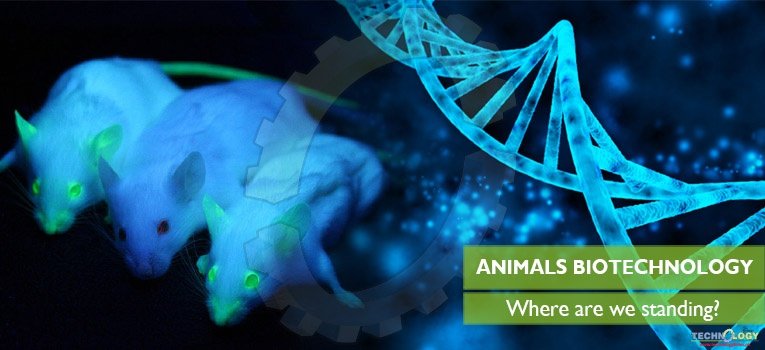The field of biology has advanced a great deal by the integration of modern technologies developed as a result of better understanding of the genomes of living beings. Around forty years back the field of biology took a gigantic leap of genetic engineering with the discovery of recombinant DNA technology. By virtue of this biotechnology, genomes can be edited to prevent diseases or acquire beneficial features.

The novel technological development eventually evolved into a new field of “Biotechnology” based on numerous molecular techniques used to modify the genome of organisms including plants, animals and microbes for the benefit of humankind.
Animal biotechnology is a specialized branch where biotechnological techniques are put into practice to make genetically improved namely transgenic animals. Genetic modification can be good or bad, it is subjective. It depends on someone’s perception and understanding.
Currently, food security is the burning issue of time. According to United Nations, existing world population stands at 7.6 billion and up till 2030 will grow to 8.6 billion. Approximately 9.8 billion people expected to inhabit the earth by 2050.
Increase in population demands for increase in food production to meet global food security challenge. As food from animal sources like milk and meat contribute valuably towards human requirements of daily protein intake, “Transgenic animal technology” can play vital role to improve the yield and quality of food from these sources.
Animal biotechnology
Animal biotechnology methods are used to develop unique transgenic animals having better genetics and production. Gradual progression in this field came by the discovery of conventional methods of DNA microinjection, utilization of embryonic stem cells and transfer of diploid somatic nuclei.
In the 21st century scientific explorations have led to next generation of genetic modifications like zinc finger nucleases, RNA interference, TALENs (Transcription activator like effector nucleases; declared as a method of choice for genome editing in the journal of “Nature” in 2011) and the most recent one CRISPR/Cas9.
All these techniques are based on the biological engineering of natural processes occurring within the living cells.
To have a futuristic idea about the emerging field, Grand View Research, Inc. a U.S. based market research and consulting company, has declared that the global genome editing market is estimated to reach USD 8.1 billion by 2025.
Under the umbrella of animal biotechnology, animals are genetically engineered for wide range of applications in medicine, industry and agriculture. Their use is important to understand the coordinated functional regulation of genes to perform various biological functions.
Genetic engineering helping us to create animal models to study normal physiological function of the human body. Disease susceptibility, progression and biosafety testing of various drugs and vaccines can also identify before their commercial applications.
Since 1980s transgenic mice is experimental model of choice due to its genome similarity to humans and short reproduction time. Accordingly, direct extrapolation of behavioral and physiological tests performed on mice to human disease is possible.
Timeline of important events in animal biotechnology
Tracking the story of historical FDA approval for the use of transgenic animals, AquaBounty Technologies produced genetically modified Atlantic salmon in 1991. This salmon has growth hormone gene from the chinook salmon and a promoter; a segment of genome that controls linked gene efficiency, from the Ocean pout.
Company filed for FDA approval to commercialize the product in 1995 and got approval after 20 years in 2015. The delayed approval of genetically modified (GM) Salmon was nightmarish for the investors, venture capitalists and industry resulting into marginal commercial investments to produce transgenic animals in developed countries.
Owing to stringent safety and ethical parameters, FDA approval proves a landmark for products of genetically modified animals. A company named as rEVO Biologics, made transgenic goats secreting antithrombin III in the milk, a therapeutic protein used to prevent post-surgical clot formation in patients with hereditary antithrombin deficiency.
The beauty of technology lies in that even a small flock of 80 goats can supply this valuable protein for whole Europe. An excellent example of contribution of animal biotechnology in human health.
In 1997, the first transgenic cow, produced human protein alpha lactalbumin enriched milk. Experimental transgenic cows are producing beta-lactoglobulin and lactose free milk for lactose intolerant persons, and low-cholesterol milk for cardiovascular patients.
Alexion, a well-known biotechnology company, has developed Chicken that secrete recombinant human lysosomal acid lipase (rhLAL) in their eggs [rhLAL is very vital in cholesterol metabolism].
Novel animal biotechnological developments have pulled huge investments. China is coming as biotechnological giant in this decade.
Till 2015, twenty genetically modified organisms were in the production line. In 2016, china expected to import one million Friesian cattle from Australia of estimated 2 billion US dollars. Thirty-one million dollars’ plant of BoyaLife in Tianjin is planning to produce one million cloned cattle up to 2020. This will help china to save revenue from lowering its imports.
Increasing sophistication in genome editing has made it possible to produce targeted alteration in animals and reevaluate them robustly.
However, moral and ethical issues like animal welfare must address with each advancement. This can achieve by reducing the number of animals in biological research. Moreover, refinement of procedures involved to minimize pain and distress to animals and use of non-animal alternatives when and wherever possible.
This century will revolutionize biology and a wrong step will be devastating for the entire human race. Everything functions efficiently within a regulated framework of core values. Engineering of organisms should regulate carefully with strict compliance to biosafety.
Conclusion
Biotechnological advancements are the need of time. On the bright side, genetically modified organisms can contribute not only to food security, but can also increase the living standard of people in developing countries. Elevation of people from poverty to an economically stable state will fuel better education, health and job opportunities.
This will resultantly culminate radicalization making the world a better, secure and peaceful place for future generations. This would favor shifting of balance of power towards a scientifically and economically advanced global village. Not towards the one having a cache of military hardware.
This article is jointly written by 1Waqas Ashraf, 2Zargham Nawaz Butt and 3Muhammad Imran Sohail. 1Former alumni of NIBGE and currently working as “Assistant Professor” in the “Department of Pathobiology, The Islamia University of Bahawalpur. 2&3M.Phil. and PhD graduates of NIBGE, Faisalabad, Pakistan.
